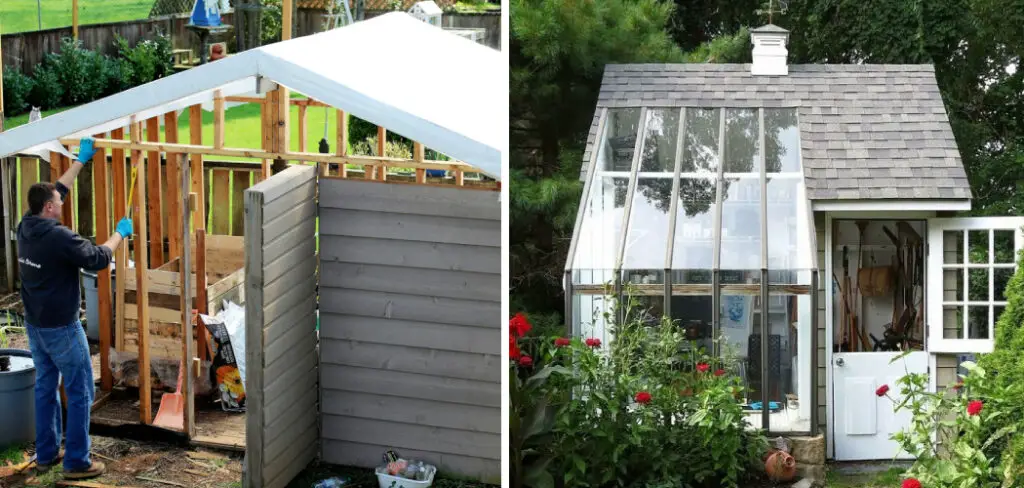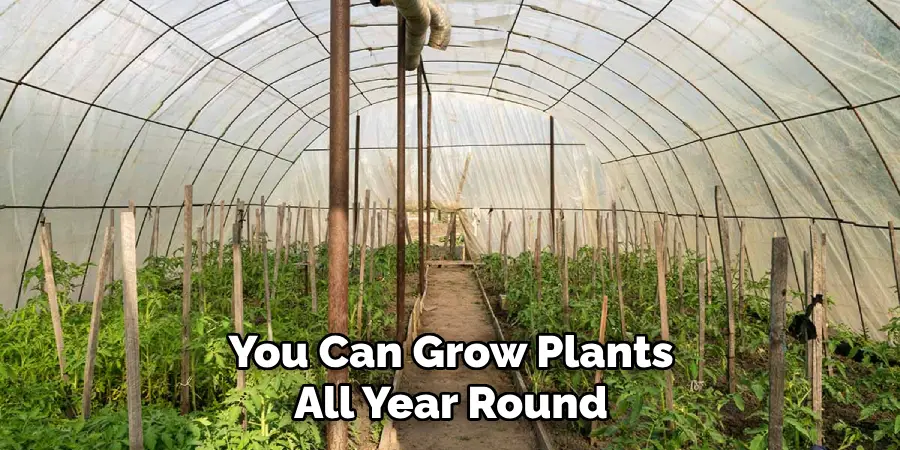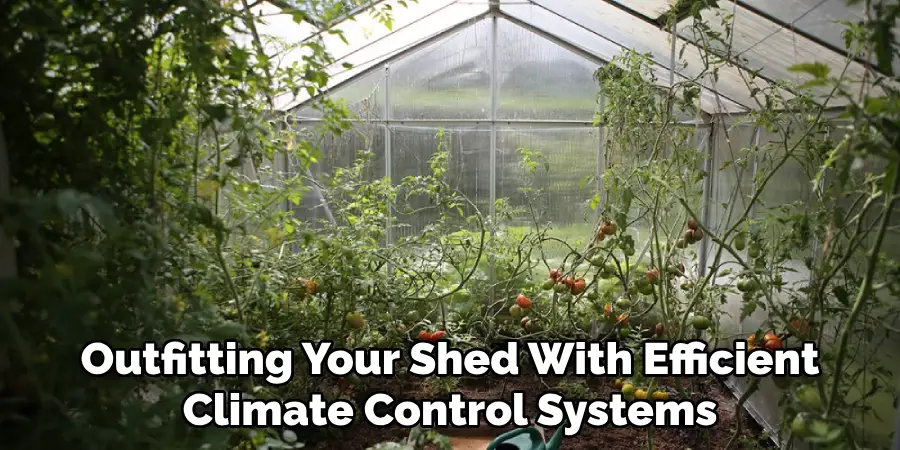If you’re anything like me and passionate about having a garden, adding a greenhouse to the mix can exponentially increase your vegetable and flower yield. Growing your own food is a great way to enjoy nature, eat healthier, and save money. But what if you don’t have enough room in your backyard for a full-sized greenhouse? Transform an old shed into the perfect greenhouse with just a few simple steps!

In this blog post, we’ll tell you how to do it quickly and easily. You’ll start by reinforcing the shed frame, adding windows or skylights, installing shelves for plants, and outfitting it with efficient climate control systems. With these tips and tricks on how to turn a shed into a greenhouse, you can create a custom growing space that will satisfy all of your gardening needs – no matter the size of your garden! Read on to learn how to create a stunning structure that will help you enjoy all the benefits of gardening while keeping costs low.
The Advantages of Having a Greenhouse
1. Suitable Atmosphere for Plant

There are numerous advantages to investing in a greenhouse. First and foremost, you can grow plants all year round, so they don’t have to rely on the changing weather conditions. You’ll also be able to control the temperature, humidity, and air circulation of your greenhouse so that it is suitable for growing whatever type of plant you want – no matter where you live.
2. More Growing Area
In addition to having a suitable atmosphere for plants, greenhouses provide more growing areas in your garden than just a traditional shed can offer. With the right design and materials, you’ll be able to make use of every inch of space in your greenhouse – from floor to ceiling! This will allow you to grow a wider variety of plants, vegetables, and flowers.
3. Cost-Effective
Finally, turning an old shed into a greenhouse is an incredibly cost-effective way to get the same benefits as having a regular greenhouse without breaking the bank. By using your existing structure rather than building from scratch, you can save money on materials, labour and time.
What to Keep in Mind While Turning a Shed Into a Greenhouse
While there are many advantages to turning an old shed into a greenhouse, it’s important to keep certain things in mind before you begin this project. To ensure the best results, pay attention to the following:
1. The Size of the Shed
Before you begin transforming your shed into a greenhouse, make sure that it’s large enough to house all of the plants and equipment you plan on using. Keep in mind that many types of greenhouses require at least 6×8 feet of space.
2. The Structure’s Condition

It’s also important to inspect the condition of your shed. Make sure that the walls, roof, and frame of your shed are in good shape before outfitting it with windows or skylights. If there’s any visible damage, be sure to fix this first before transforming it into a greenhouse – otherwise, you might end up with an unstable structure!
3. Climate Control Systems
Climate control systems are essential for a successful greenhouse. You’ll need to install an efficient ventilation system, such as fans or air conditioners, in order to keep the temperature and humidity levels regulated. Additionally, you may have to invest in additional energy-efficient materials, such as heaters or insulation, depending on where you live and how much money you’re willing to spend.
Required Items for Turning a Shed Into a Greenhouse
In addition to making sure that your shed is in good condition and large enough to house your plants, there are other items you’ll need before turning it into a greenhouse. Here is a list of essential items:
- Reinforcement materials (such as lumber or plywood)
- Windows or skylights
- Shelves and racks for your plants
- Insulation materials
- Climate control systems (such as fans, air conditioners or heaters)
How to Turn a Shed Into a Greenhouse in 10 Ways
Now that you know the advantages and things to keep in mind about turning an old shed into a greenhouse, let’s get into the nitty-gritty of how to do it step-by-step:
1. Reinforce the Shed Frame

The first step in turning a shed into a greenhouse is to reinforce its frame and walls. This will ensure that your structure will remain sturdy and secure, even when faced with extreme temperature fluctuations or bad weather conditions. To do this, make sure to use high-quality materials such as lumber or plywood for the walls and roof of your shed.
2. Install Windows or Skylights
The next step is to install windows or skylights in your shed, which will allow the natural light to enter and heat up the space inside your greenhouse. This will make sure that your plants get enough sunlight for photosynthesis – an essential process of growth!
3. Choose Shelving for Your Plants
Now it’s time to choose the right shelves and racks for your plants. Depending on how much space you have in your greenhouse, you may want to consider installing vertical planters or hanging pots from the ceiling.
4. Outfit Your Shed with Climate Control Systems
The next step is outfitting your shed with efficient climate control systems. This could include air conditioners, fans, and heaters – depending on your needs and the type of plant you’re growing.

5. Seal Your Shed
Your shed needs to be sealed in order to keep the warm, humid air inside and prevent any drafts or leaks from entering your greenhouse. To do this, you’ll need to use materials such as weatherstripping or foam insulation.
6. Install Lighting
In addition to providing your plants with natural light, it’s important to install lighting fixtures inside your shed in order to ensure that they get enough artificial light for photosynthesis. Make sure the lighting is energy-efficient and can be adjusted to the needs of different plants.
7. Install a Drainage System
In order for your plants to stay healthy, it’s important that you install a drainage system in your shed. This is especially important if you plan on watering the plants manually – as excess water will need somewhere to go!
8. Choose Appropriate Ventilation
To ensure that the air inside your greenhouse is circulating properly, it’s important to choose appropriate ventilation systems. This can include fans or vents in order to regulate temperature and humidity levels.
9. Create a Drip System for Watering Plants
If you’re looking to save time and energy when watering your plants, then you may want to consider installing a drip system. This will allow you to save time and money by setting up an automated watering schedule for your plants.
10. Monitor the Temperature
In order for your plants to grow healthily, it’s important that you monitor the temperature inside your greenhouse regularly. If there are extreme temperature fluctuations, you may need to adjust your fan or ventilation system.
Following these 10 steps will help ensure that you have a successful greenhouse that is safe and secure. With the right materials, climate control systems, and ventilation, your plants will be able to grow in optimal health!
8 Maintenance Tips
Once your shed has been converted to a greenhouse, you’ll want to keep it in good working order. Here are some maintenance tips that will help you make sure your new greenhouse stays healthy and productive:
- Clean the glazing regularly. Whether it’s glass, plastic film, or polycarbonate sheets, regular cleaning will keep the light transmission at its best.
- Check the frame for signs of rust or rot and repair any damage as needed. This will help ensure that your greenhouse remains structurally sound and safe.
- Make sure all seals are in good condition to help prevent condensation, mildew, and other issues from developing inside the greenhouse.
- Ventilate your shed-turned-greenhouse regularly to keep temperatures and humidity levels in check.
- Prune away any dead or dying plants from inside the greenhouse, as these can attract pests and disease.
- Install an insect screen at the entrance of your greenhouse to prevent bugs from entering and causing damage to your plants.
- Replace any broken fixtures or pieces of equipment, such as fans or heating systems.
- Sterilize the interior of the greenhouse periodically to ensure that no harmful pests or diseases are present. It would also be a good idea to fertilize the soil and provide proper nutrition for your plants.
By following these tips, you’ll be able to keep your shed-turned-greenhouse in top condition and reap a bountiful harvest of fruits and vegetables. With some basic maintenance and care, your new greenhouse will be a thriving and productive environment ideal for growing your favorite plants.
Conclusion
With the help of these tips on how to turn a shed into a greenhouse, you can turn your old shed into a beautiful and functional greenhouse. You will now enjoy gardening more and get creative with your green thumb! Remember to take the necessary precautions for safety and structurally sound DIY greenhouses when you start planning the addition of your greenhouse to your outdoor space.
From foundation to roof, apply the lessons discussed in this blog post and make sure everything is correctly fitted. With a bit of hard work, creativity, and planning, you, too, can make an inspiring DIY shed-greenhouse project come to life! After all, what better way to become a master of growing plants than by building your very own shelter?
About
Outdoor Fixes is a distinguished figure in the world of Diy design, with a decade of expertise creating innovative and sustainable Diy solutions.
His professional focus lies in merging traditional craftsmanship with modern manufacturing techniques,
fostering designs that are both practical and environmentally conscious. As the author of diy,
outdoorfixes delves into the art and science of outdoorfixes-making, inspiring artisans and industry professionals alike.
Education RMIT University
(Melbourne, Australia) Associate Degree in Design (Outdoor Fixes) Focus on sustainable design, industry-driven projects,
and practical craftsmanship. Gained hands-on experience with traditional and digital manufacturing tools, such as CAD and CNC software.
Nottingham Trent University
(United Kingdom) Bachelor’s in outdoorfixes.com and Product Design (Honors) Specialized in product design with a focus on blending creativity with production
techniques. Participated in industry projects, working with companies like John Lewis and Vitsoe to gain real-world insights.
Publications and Impact
In diy, Outdoor Fixes his insights on indoor design processes, materials, and strategies for efficient production.
His writing bridges the gap between artisan knowledge and modern industry needs, making it a must-read for both budding designers and seasoned professionals.

